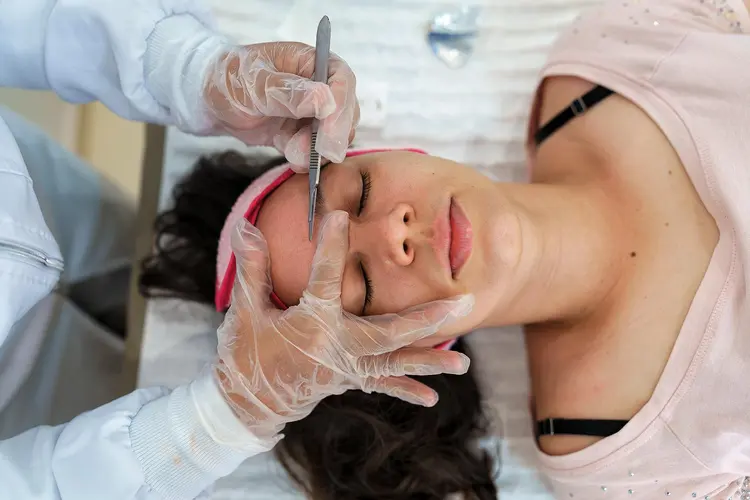
- What Is Dermaplaning?
- Benefits of Dermaplaning
- Dermaplaning Side Effects
- Where Can You Get the Dermaplaning Procedure Done?
- How to Prepare for Dermaplaning
- Dermaplaning Procedure
- Skin Care After Dermaplaning
- Dermaplaning at Home
- Takeaways
- Dermaplaning FAQs
Dermaplaning: A Complete Guide to the Procedure, Benefits, and Aftercare
What Is Dermaplaning?
Dermaplaning is a cosmetic treatment where a licensed professional—such as a plastic surgeon, dermatologist, or cosmetologist—uses a sterile scalpel to gently scrape away dead skin cells and fine facial hair (often called “peach fuzz”). While it removes light facial hair, dermaplaning differs from shaving in three key ways: the tools used (sterile medical scalpel vs. regular razor), the amount of skin removed (exfoliates dead skin layers vs. only cutting hair), and the provider (trained professional vs. at-home self-application).
Dermaplaning vs. Dermabrasion
Both dermaplaning and dermabrasion are facial procedures designed to improve skin appearance, and both may reduce fine lines, wrinkles, and uneven tone. However, they differ significantly in invasiveness and use cases:
- Dermabrasion: As the name suggests, this procedure involves “sanding” or abrading the skin’s surface (typically with a rotating tool) to remove deeper layers. It is more invasive and is often used for more severe concerns, such as deep acne or pox scars, skin growths, stretch marks, or tattoo removal.
- Dermaplaning: A less invasive option that only targets the outermost layer of dead skin and peach fuzz.
If you have sensitive skin or a darker skin tone, you may face a higher risk of scarring or pigmentation changes with dermabrasion—making dermaplaning a safer alternative.
Benefits of Dermaplaning
The benefits of dermaplaning vary based on your skin type, tone, medical history, and the skill of the provider. Key cosmetic benefits may include:
- Brighter, more youthful-looking skin
- Removal of fine facial hair (peach fuzz)
- Reduced appearance of fine lines and wrinkles
- Smoother skin texture
- Diminished hyperpigmentation
- More even skin tone
- Reduced bacteria and unclogged pores (helping limit future breakouts)
- Softened appearance of deep acne or pox scars
For optimal results, seek a referral to a well-reviewed, licensed practitioner in your area.
Dermaplaning Side Effects
Most people experience little to no irritation after dermaplaning. Short-term side effects may include:
- Temporary redness or swelling from the gentle scraping
- Mild soreness
- A burning or tingling sensation (typically resolving within 48 hours)
A common myth about dermaplaning is that hair grows back thicker or darker. While regrown hair may feel slightly coarser initially (due to the blunt edge left by the scalpel), it will soften over time and return to its original texture.
Who Should Avoid Dermaplaning?
Dermaplaning is not recommended if you have:
- Inflammatory skin conditions (e.g., active acne, rosacea, psoriasis, eczema)
- Sunburn
Additionally, if you are taking isotretinoin (a prescription medication for severe acne), you must wait 6 months after stopping the drug before undergoing dermaplaning (isotretinoin increases skin sensitivity and risk of scarring).
Why Do I Break Out After Dermaplaning?
Breakouts after dermaplaning are not universal and often stem from:
- Improper technique or unsterile tools (which can spread bacteria)
- Undergoing the procedure during an active acne breakout (bacteria from existing blemishes may spread to other areas)
If you have active acne, avoid dermaplaning until your skin clears. When performed correctly, dermaplaning may reduce future breakouts by removing dead skin buildup that clogs pores.
Where to Get Dermaplaning Done
The safest option is to visit a licensed aesthetician, dermatologist, or plastic surgeon—professionals with the training to use sterile tools and avoid injury.
At-home dermaplaning kits are available online or in drugstores, but they carry significant risks: using a sharp blade without proper training can lead to cuts, infections, or uneven exfoliation (which may cause scarring).
How to Prepare for Dermaplaning
- Cost: Dermaplaning is considered a cosmetic procedure and is not covered by insurance, so you will need to pay out of pocket.
- Duration: Most sessions take 30 minutes, though full-face treatments may last up to 90 minutes.
Pre-Procedure Steps (Advised by Your Provider):
- Discuss your goals for the treatment (e.g., hair removal, scar softening).
- Undergo a skin examination to confirm your skin is healthy enough for the procedure.
- Review your medical history (including medications like isotretinoin).
- Avoid exfoliating (e.g., scrubs, chemical exfoliants) for 3 days before the session.
- Avoid direct sunlight or tanning to prevent added skin sensitivity.
What Happens During a Dermaplaning Session?
Dermaplaning is a noninvasive, outpatient procedure. Here’s what to expect:
- Cleansing: Your provider will first cleanse your skin—often with an alpha-hydroxy or beta-hydroxy acid—to loosen dead skin cells.
- Numbing (Optional): While dermaplaning is not painful when done correctly, a mild numbing cream may be applied as a precaution (especially for sensitive skin).
- Exfoliation & Hair Removal: Using a sterile scalpel held at a 45-degree angle, your provider will gently glide the blade over your skin to scrape away dead cells and peach fuzz.
- Duration: Timing depends on the area treated—full-face sessions typically take 30 minutes, but larger areas may take up to 90 minutes.
Skin Care After Dermaplaning
Post-procedure care is critical to protect your newly exfoliated (and temporarily sensitive) skin. Your provider will likely recommend:
- Avoiding harsh cleansers, toners, or exfoliants for several days.
- Applying a gentle, soothing moisturizer daily.
- Using a broad-spectrum sunscreen with an SPF of 30+ (reapply every 2 hours if outdoors)—exfoliated skin is more vulnerable to UV damage.
- Avoiding direct sunlight and heavy makeup for 1–2 days.
There is no downtime required for recovery. Most people can resume normal activities immediately.
How Often Can You Get Dermaplaning?
Dermaplaning can be done every 3–4 weeks, as this is how long it typically takes for dead skin cells to rebuild and facial hair to regrow. Note that it will not eliminate all acne scars or stop the aging process—it is a maintenance procedure, not a permanent solution.
Dermaplaning at Home
Dermaplaning should only be performed by a trained, licensed professional. At-home kits may seem convenient, but they lack the sterility and precision of a professional treatment. Without proper training, you risk cuts, infections, scarring, or uneven skin texture.
Key Takeaways
Dermaplaning is a noninvasive, low-risk procedure that exfoliates dead skin and removes facial peach fuzz. For the best and safest results:
- Choose a highly experienced, licensed provider who uses sterile tools and techniques.
- Avoid the procedure if you have active inflammatory skin conditions or are on isotretinoin.
- Prioritize post-treatment sun protection and gentle skincare.
For those without severe skin concerns, dermaplaning can effectively brighten, smooth, and soften the skin.
Dermaplaning FAQs
Is dermaplaning good for your skin?
Dermaplaning is beneficial for people without severe skin issues (e.g., eczema, psoriasis, active acne). It can even skin tone, brighten dull complexions, and remove unwanted facial hair.
What is the downside of dermaplaning?
Potential downsides include temporary breakouts, cuts, or scarring (especially with unsterile tools or improper technique). Costs typically range from $100–$300 per session, and full results may take several months to appear. Results also vary based on provider quality and individual skin type.
What happens when hair grows back after dermaplaning?
Hair does not grow back thicker or darker. However, it may regrow at a slightly different angle, which can temporarily change how it looks or feels. Dermaplaning does not permanently remove hair, so ongoing sessions (every 3–4 weeks) are needed to maintain results. Hair regrowth speed varies by individual.





